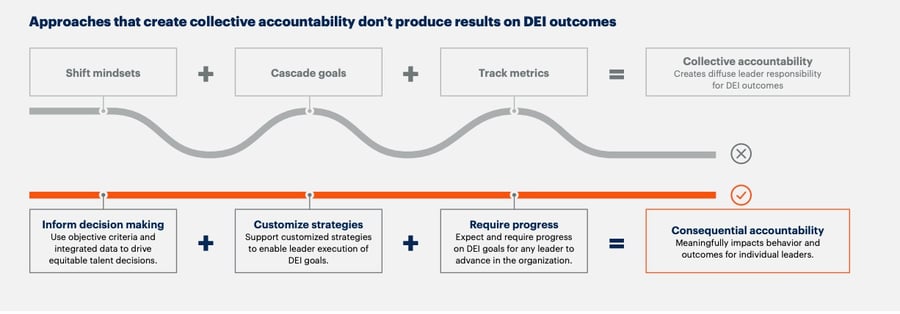This article was updated in February 2022 to reflect new workplace diversity statistics and data.
The importance of workplace diversity can’t be understated. The business case has long been made, with Harvard Business Review reporting on the value of a diverse workforce since 1996. Diversity boosts creativity and innovation, leads to better decision-making, and results in a more professionally enriching environment, according to Forbes.
Not to mention, as you’ll read, job seekers largely prefer to work for companies that walk the walk when it comes to diversity, equity, inclusion, and belonging. That means focusing on more than just demographics. According to HBR, “Increasing the numbers of traditionally underrepresented people in your workforce does not automatically produce benefits.” Businesses need to make a real commitment to creating a workplace culture that supports DEI from the top down.
“Leaders must acknowledge that increasing demographic diversity does not, by itself, increase effectiveness; what matters is how an organization harnesses diversity, and whether it’s willing to reshape its power structure.”
- Harvard Business Review
Here are twelve workplace statistics that highlight the increasing importance of DEI and where we still need to do better. We’re also sharing some hiring tips to help you notice potential bias and avoid biased hiring practices.
1. 76% of employees and job seekers said diversity was important when considering job offers.
Job seekers — and your own employees — want to know that their workplace values the same things they do, and they’re vocal about diversity being a top priority. And they’re not just saying that — workers won’t tolerate a discriminatory work environment:
- Over half of Black and Hispanic workers said they had quit a job after seeing racial discrimination at work or experiencing it firsthand.
- 37% of workers and job seekers said they wouldn’t apply to a company that was rated negatively by people of color.
2. 35% of HR leaders say diversity, equity, and inclusion are among their top five priorities for 2022.
HR leaders are listening to what job seekers today are saying and named diversity, equity, and inclusion as a top priority in 2022. One disparity they may address is the stalled leadership progression of women and minorities, of whom only 29% and 17%, respectively, reach the C-suite level.
According to Gartner, one way to make more tangible progress toward DEI goals in 2022 is to hold leaders accountable, vs. the collective accountability approach that many companies have taken. Check out the graphic below (from Gartner's Top 5 HR Trends and Priorities 2022) for a strategy that can help your organization reach more of its DEI goals this year.

Here are some ways to ensure DEI stays at the top of HR’s priority list for years to come.
- Make it a team effort. Get insight, feedback, and support for DEI strategies from other members of senior management. Getting commitment from the executive team is an important step in making real change happen throughout the company.
- Create a DEI committee. This could be a small group made up of senior leaders, managers, and team members who collaborate on ways to promote diversity in the workplace. This group itself should be diverse in employee position, race, gender, age, etc. A team that lacks diversity won’t have the perspectives needed for impactful outcomes.
- Get inspired by other companies. Today, diversity is a group effort, in that organizations of all sizes and industries are making it a priority. Look to others who are succeeding to inspire new ideas for your own company on its DEI journey.
- Be honest. Even seasoned leaders can struggle with understanding how to commit to creating a diverse, equitable, and inclusive workplace. Be honest about where your company stands, how it plans to improve, and the progress it makes.
3. 89% of people want their company to be inclusive of individuals with intellectual disabilities.
This diversity statistic makes it clear that most employees want inclusive workplaces that consider all forms of diversity. But only 45% of those respondents believe their company’s DEI policies actually do include those with intellectual disabilities (ID).
One way to become more inclusive to people with ID is to both hire them and to ensure they have access to learning opportunities at work.
4. Top companies hired 242% more Black directors in 5 months in 2020.
In the five months following George Floyd’s death in May 2020, companies in the Russell 3000 hired 130 Black directors, compared to just 38 in the five months prior. That staggering 242% increase makes it clear that more diverse hiring is possible — companies just need to commit to it.
5. Racially and ethnically diverse companies have a 36% higher likelihood of financially outperforming less diverse companies.
Higher racial, ethnic, and gender diversity on leadership teams makes it much more likely that those companies will outperform those with less diverse teams. That’s because increased diversity means a wider range of perspectives and broader understanding that can positively impact creativity. Diverse teams are less likely to fall into the same problem-solving patterns that emerge in homogenous environments, leading to more innovative solutions.
There’s a glaring business case for increasing #diversity in the workplace: diverse companies were found to outperform their peers. See more important diversity statistics from @ClearCompany:6. Only 47% of managers feel prepared to have conversations about race with their employees.
According to the same Gallup study, only 41% of U.S. managers said they had received training or education around diversity, equity, inclusion, racism, racial justice, or other related topics. Just as with any other skill, a lack of training leaves employees feeling unprepared.
Luckily, the research also shows that even one training session or program can help managers feel more prepared to have those meaningful conversations.
7. Gen Z is the most racially and ethnically diverse generation — ever.
Gen Z is the most diverse generation in U.S. history. 52% identify as white, one in four as Hispanic, 14% as Black, 6% as Asian, and 5% as another race or two or more races. In comparison, 61% of Millennials identified as white in 2002. In addition, Gen Z is expected to become the majority in the workforce within the next ten years.
That’s important because Gen Z’s expectations of their employers are different from their parents, grandparents, and even older siblings. The youngest generation in the workforce wants to work for companies that engage with social issues and prioritize diversity.
Three Ways to Reduce Bias in Hiring
- Talk about it: You have to acknowledge that bias exists in order to reduce its effects.
- Hire collectively: Include diverse perspectives in the creation of the hiring process and in everyday hiring.
- Structure interviews: A structured interview process ensures that all candidates are evaluated on a level playing field.
8. Blind applications increase women’s chances of getting hired by up to 46 percent.
One study also found that men are twice as likely to be hired as women, regardless of the hiring manager’s gender. That means that even women can be biased against other women, magnifying the need for hiring practices that reduce bias in addition to DEI training for managers.
9. At top companies, only 8% of C-suite executives are Black.
The Washington Post found that at the 50 most valuable public companies in the U.S., only 8% of top executives were Black. At least eight companies, including Walmart, employed no Black executives at all.
That’s a problem that Rhonda Morris, chief human resources officer, and Lee Jourdan, former chief diversity and inclusion officer, addressed at Chevron. Morris and Jourdan began using inclusion counselors, neutral observers who sat in on promotion and role assignment meetings. The inclusion counselors were trained to identify biases in conversations and help hiring teams avoid groupthink.
10. Candidates with distinctively Black names are 2.1% less likely to be contacted by employers.
A recent study involving over 83,000 job applications found that compared to applicants with distinctively white names, those with distinctively Black names were less likely to be contacted by an employer. This isn’t a new finding; similar studies have been conducted since the 1970s.
This is why it’s important for hiring teams to understand unconscious bias. Individuals should be hired based on candidates’ skills, abilities, and experience, not by their name or ethnic background.
Unfortunately, unconscious biases are still very much a part of the interview and hiring decisions. Fortunately, there are things you can do to prevent bias from interfering:
- Create a standard process. Create a list of questions that every candidate must answer and skills they must have. Consistency ensures everyone has an equal opportunity to demonstrate their qualifications.
- Make a justified decision. Look over your notes and honestly evaluate why a candidate is (or isn’t) the best fit instead of making an instant decision. Justify your reasoning and make sure that it is based on facts rather than assumptions. Work with a diverse hiring team to help reduce bias.
“Workers who are satisfied with their company’s efforts on [DEI] issues are actually happier with their jobs. They are more likely than others to say that they have good opportunities to advance their careers, and they are more likely to feel like they are paid well for the work they do.”
- Laura Wronski, Research Science Manager at SurveyMonkey
11. Companies that welcome diversity are 1.7x more innovative.
A huge benefit of a diverse workforce is the wide range of perspectives that come together to collaborate and solve problems. When people with varied viewpoints, experiences, and abilities discuss problems, they tend to come up with more innovative solutions.
That makes sense — a room full of people whose experiences and backgrounds are very similar are going to have a narrower range of ideas compared to a room full of people who are very different from one another. Embracing diversity can then help companies continue to attract and retain diverse, innovative talent.
12. Companies with gender-diverse executive teams are 21% more likely to outperform on profitably.
Data also found that the more gender-diverse the team, the higher the likelihood of outperformance. In other words, the more women there were on executive teams, the more likely it was that the company would outperform its peers.
Among Russell 3000 companies, gender representation is on the rise, with women holding 25% of board seats in 2021. Among private companies, however, the numbers are not as promising — 60% of companies have no women on their board. That lack of representation certainly hurts companies’ bottom lines, considering that when women are on executive teams, earnings (before interest and tax) improve by as much as 55 percent.
There are far more than twelve reasons to diversify your workforce, but these workplace diversity statistics highlight some important ones. Your employees demand diversity, and it results in higher profitability and more creative outcomes.
Wondering where your company should start or continue its journey to becoming more diverse, equitable, and inclusive? Taking steps to reduce and eliminate hiring bias is always impactful:
- Learn and understand: Understand how the unconscious bias of one person toward another can affect hiring decisions.
- Educate and train: Provide your hiring team with training that helps them notice and reduce bias in the recruiting process.
- Evaluate and implement: Evaluate your hiring process and make changes if necessary, like removing gendered language from job descriptions.
Reducing biases in your hiring process is a great place to start your DEI initiatives — and ClearCompany is a great place to continue learning more. Find out more about the importance of diversity, equity, and inclusion with ClearCompany’s DEI resources. Start by downloading 5 Tips For Better Diversity Hiring.



